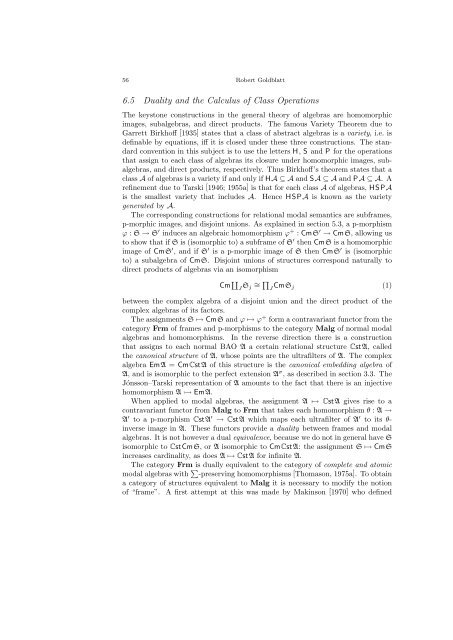MATHEMATICAL MODAL LOGIC: A VIEW OF ITS EVOLUTION
MATHEMATICAL MODAL LOGIC: A VIEW OF ITS EVOLUTION
MATHEMATICAL MODAL LOGIC: A VIEW OF ITS EVOLUTION
You also want an ePaper? Increase the reach of your titles
YUMPU automatically turns print PDFs into web optimized ePapers that Google loves.
56 Robert Goldblatt6.5 Duality and the Calculus of Class OperationsThe keystone constructions in the general theory of algebras are homomorphicimages, subalgebras, and direct products. The famous Variety Theorem due toGarrett Birkhoff [1935] states that a class of abstract algebras is a variety, i.e. isdefinable by equations, iff it is closed under these three constructions. The standardconvention in this subject is to use the letters H, S and P for the operationsthat assign to each class of algebras its closure under homomorphic images, subalgebras,and direct products, respectively. Thus Birkhoff’s theorem states that aclass A of algebras is a variety if and only if HA ⊆ A and SA ⊆ A and PA ⊆ A. Arefinement due to Tarski [1946; 1955a] is that for each class A of algebras, HSPAis the smallest variety that includes A. Hence HSPA is known as the varietygenerated by A.The corresponding constructions for relational modal semantics are subframes,p-morphic images, and disjoint unions. As explained in section 5.3, a p-morphismϕ : S → S ′ induces an algebraic homomorphism ϕ + : CmS ′ → CmS, allowing usto show that if S is (isomorphic to) a subframe of S ′ then CmS is a homomorphicimage of CmS ′ , and if S ′ is a p-morphic image of S then CmS ′ is (isomorphicto) a subalgebra of CmS. Disjoint unions of structures correspond naturally todirect products of algebras via an isomorphismCm ∐ J S j ∼ = ∏ J CmS j (1)between the complex algebra of a disjoint union and the direct product of thecomplex algebras of its factors.The assignments S ↦→ CmS and ϕ ↦→ ϕ + form a contravariant functor from thecategory Frm of frames and p-morphisms to the category Malg of normal modalalgebras and homomorphisms. In the reverse direction there is a constructionthat assigns to each normal BAO A a certain relational structure CstA, calledthe canonical structure of A, whose points are the ultrafilters of A. The complexalgebra EmA = CmCstA of this structure is the canonical embedding algebra ofA, and is isomorphic to the perfect extension A σ , as described in section 3.3. TheJónsson–Tarski representation of A amounts to the fact that there is an injectivehomomorphism A ↣ EmA.When applied to modal algebras, the assignment A ↦→ CstA gives rise to acontravariant functor from Malg to Frm that takes each homomorphism θ : A →A ′ to a p-morphism CstA ′ → CstA which maps each ultrafilter of A ′ to its θ-inverse image in A. These functors provide a duality between frames and modalalgebras. It is not however a dual equivalence, because we do not in general have Sisomorphic to CstCmS, or A isomorphic to CmCstA: the assignment S ↦→ CmSincreases cardinality, as does A ↦→ CstA for infinite A.The category Frm is dually equivalent to the category of complete and atomicmodal algebras with ∑ -preserving homomorphisms [Thomason, 1975a]. To obtaina category of structures equivalent to Malg it is necessary to modify the notionof “frame”. A first attempt at this was made by Makinson [1970] who defined
















